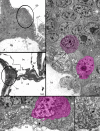Organization and metamorphic remodeling of the nervous system in juveniles of Phoronopsis harmeri (Phoronida): insights into evolution of the bilaterian nervous system
- PMID: 24847374
- PMCID: PMC4026883
- DOI: 10.1186/1742-9994-11-35
Organization and metamorphic remodeling of the nervous system in juveniles of Phoronopsis harmeri (Phoronida): insights into evolution of the bilaterian nervous system
Abstract
Background: Metamorphic remodeling of the nervous system and its organization in juvenile may shed light on early steps of evolution and can be used as an important criterion for establishing the relationships among large groups of animals. The protostomian affiliation of phoronids does not still have certain morphological and embryological proofs. In addition, the relationship of phoronids and other former "lophophorates" is still uncertain. The resolving of these conflicts requires detailed information from poorly investigated members of phoronids, such as Phoronopsis harmeri.
Results: During metamorphosis, the juvenile consumes the nerve elements of the larval hood. Two dorsolateral groups of larval perikarya remain and give rise to the dorsal ganglion, which appears as the "commissural brain". The juvenile inherits the main and minor tentacular nerve rings from the larva. Although the larval tentacles are directly inherited by the juvenile in P. harmeri, the ultrastructure and location of the definitive tentacular neurite bundles change greatly. Innervation of the juvenile lophophore exhibits a regular alternation of the intertentacular and abfrontal neurite bundles. The giant nerve fiber appears at early stage of metamorphosis and passes from the right group of dorsolateral perikarya to the left side of the body.
Discussion: THE METAMORPHIC REMODELING OF THE PHORONID NERVOUS SYSTEM OCCURS IN TWO DIFFERENT WAYS: with complete or incomplete destruction of organ systems. The morphology of the lophophore seems similar to those of the former members of "Lophophorata", but its innervation differs greatly. These findings support the separation of bryozoans from Lophophorata and establish a need for new data on the organization of the brachiopod nervous system. The nervous system of the phoronid juvenile is organized as an epidermal nerve plexus but exhibits a nerve center in the anterior portion of the body. The simultaneous presence of both the apical organ and anlage of the cerebral ganglion in phoronids at the larval stage, and the reduction of the apical organ during metamorphosis support the Trochea theory and allow to suggest the presence of two nervous centers in the last common ancestor of the Bilateria. Phoronids retained some plesiomorphic traits and can be regarded as one of the most primitive groups of lophotrochozoans.
Keywords: Deuterostomia; Evolution; Lophophorata; Metamorphosis; Nervous system; Phylogeny; Protostomia; The last common bilaterian ancestor.
Figures












References
-
- Temereva EN. New data on distribution, morphology and taxonomy of phoronid larvae (Phoronida, Lophophorata) Invert Zool. 2009;6(1):47–64.
-
- Temereva EN, Neretina TV. A distinct phoronid larva: morphological and molecular evidence. Invert Syst. 2013;27(6):622–633.
-
- Temereva EN, Malakhov VV. The evidence of metamery in adult brachiopods and phoronids. Invert Zool. 2011;8:87–101.
-
- Altenburger A, Wanninger A, Holmer LE. Metamorphosis in Craniiformea revisited: Novocrania anomala shows delayed development of the ventral valve. Zoomorphology. 2013;132(4):379–387. doi: 10.1007/s00435-013-0194-3. - DOI
LinkOut - more resources
Full Text Sources
Other Literature Sources
Molecular Biology Databases
Research Materials

